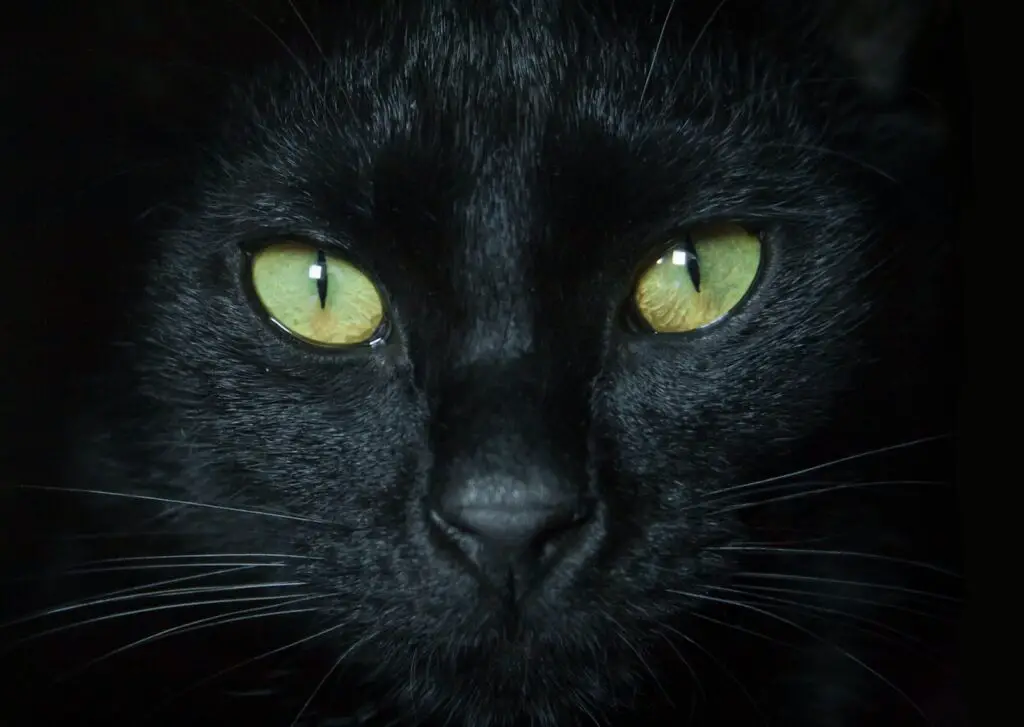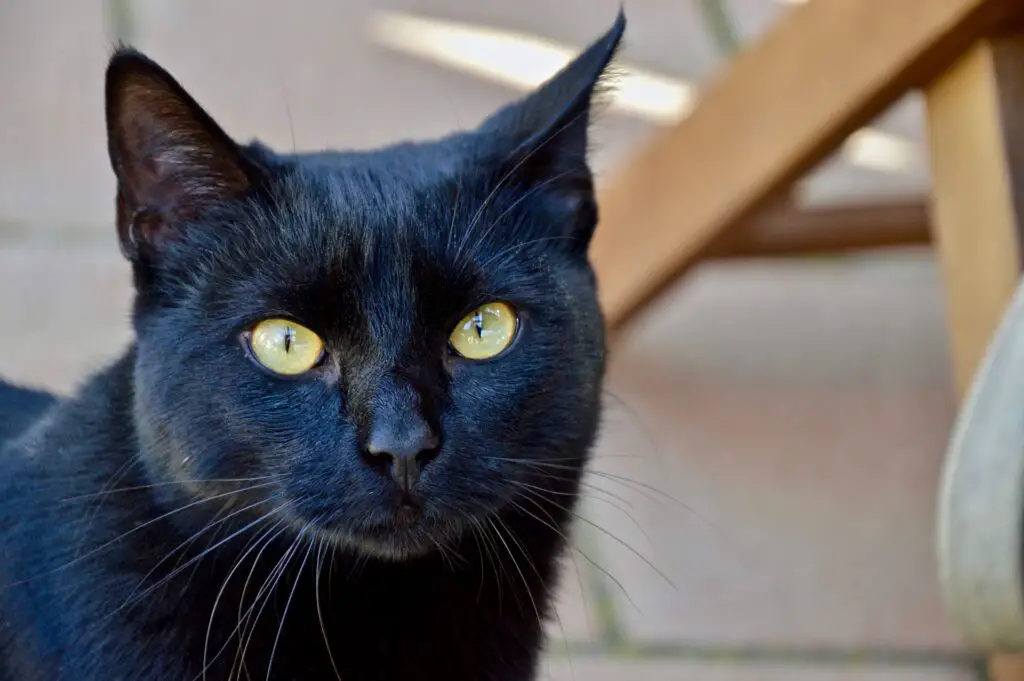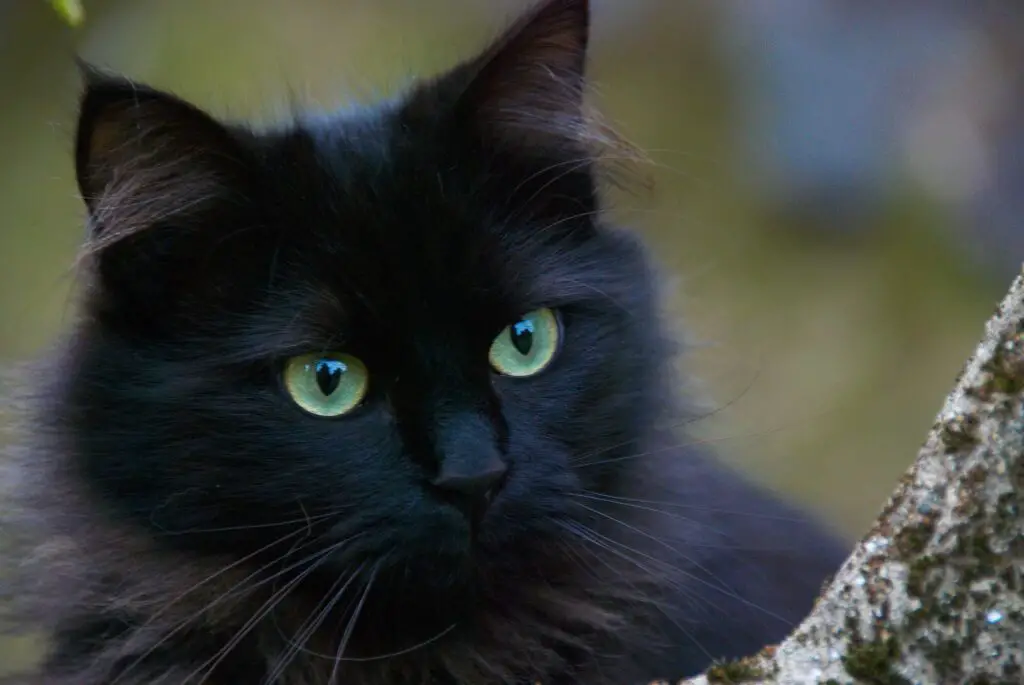
Have you ever noticed how black cats always seem to look a bit different in sunlight?
It’s not an illusion–black cats often have hidden coats of fur that cannot be seen with the naked eye.
This phenomenon, called ‘under the fur,’ is fascinating and has been studied by researchers for decades.
In this article, we’ll take a deep dive into the science behind under the fur and explore why some black cats appear to be two colors at once.
So if you’ve ever wondered what lies beneath your furry friend’s sleek coat, read on!
The Different Skin Colorations Of Black Cats
Melanistic cats are black cats with a genetic mutation that gives them their distinct coloration.
Silver/Smoke fur is caused by a gene that makes the fur look greyish.
Blue/Grey fur is caused by a dilution of the black fur, which gives it a bluish tint.
Melanistic Cats
When it comes to black cats, one of the most interesting skin colorations is melanistic cats. These cats have an excess production of melanin in their fur that gives them a dark hue and they often appear black or very dark brown. This extra pigment also affects their eyes which may be yellow, green or orange instead of the typical blue we usually associate with felines.
Though these cats are not as common as other cat breeds, they can still be found in many households around the world thanks to their striking beauty and unique look. Melanistic cats make up 10-15% of all black cat populations and provide a remarkable sight due to their intense coloring compared to other feline varieties.
All this goes to show that there’s much more than meets the eye when it comes to understanding the hidden skin colors of black cats!
Silver/Smoke Fur
Besides melanistic cats, another fascinating skin coloration found in black cats is silver or smoked fur.
The unique look of this coat and the variety that comes with it often leave people questioning if these cats have black skin underneath their coats – but the answer to this question is actually surprising!
Unlike other cat breeds, many do not possess a completely black layer of pigmentation on their skin; rather they may have white spots scattered throughout dark fur.
This can give them an interesting appearance as some parts of their body appear darker while others are lighter due to a lack of pigment.
It’s definitely one of those cases where you don’t know what’s beneath until you get up close and personal!
Blue/Grey Fur
But that’s not all!
Another variation of black cats is those with blue or grey fur.
These cats often appear more vibrant when in the sunlight, and can look almost like a charcoal-colored black cats in the sun.
The subtle differences between silver/smoke and blue/grey coat colors are usually seen through the eyes — some may have greenish-blue eye color instead of yellow or orange.
Whatever color their eyes might be, these cats always seem to make an impression no matter where they go!

How Skin Color Is Inherited
The different skin colorations of black cats are a fascinating topic. While it may appear that all black cats have the same solid coat, what lies beneath is often surprising—black cats can actually have pink, grey, and even blue-gray undertones!
Many people find themselves asking: what color skin do black cats have? And what color is a black cat’s skin? In order to understand how different colors are inherited in black cats, we need to look at genetics.
All mammals possess two sets of genes – one from each parent – which determine characteristics such as eye color or hair texture. For example, when it comes to skin tone, kittens will inherit either dark (brown/black) or light (pink) tones from their parents and these combinations result in various shades ranging from deep coal gray to pale lavender.
These variations occur because of the interaction between several genetic factors including melanin production and patterning on top of the base layer of pigmentation. This means that two individual cats can come from the same litter with similar physical attributes but display distinctively different colored fur due to differences in gene expression.
With this knowledge, we can now explore how skin color changes over time.
How Fur Color Changes Over Time
The color of a black cat’s fur is not always the same. It can change over time, and this can be due to various factors like age, diet, or genetics.
A young kitten may have a light grey or brownish hue in its fur that gradually darkens as it matures; alternatively, it could remain the same shade throughout its life. Similarly, changes in nutrition or exposure to environmental elements such as sunlight may cause an older cat’s fur to become lighter or darker than what was originally present when they were younger.
Even if these external influences do not affect their fur color, a genetic mutation within the breed itself might result in some cats having variations of hues in their coats compared to others.
In addition to encompassing a range of shades depending on individual circumstances, there are also other aspects that should be taken into consideration when discussing black cats’ hidden skin color. Depending on the environment they live in and any medical conditions they possess, their underlying pigment will differ from one another – sometimes even among littermates with similar phenotypes.
This means that despite sharing similarities at first glance, each cat has unique features that make them special and distinct from one another beneath the surface.
From the outside looking in, we may see two black cats that look very much alike but never truly know how different they really are until further inspection takes place. With each variation representing something new and interesting about our furry friends, understanding just how dynamic their coloring can open up possibilities for captivating conversations regarding their true nature – leading us directly into considering breeding black cats to enhance certain qualities associated with their pigmentation.

Breeding Black Cats To Enhance Color
Breeding black cats to enhance their color can be a tricky endeavor. Many breeders have found that purebred black cats tend to display hues of blue, gray, and green in their fur when placed in direct sunlight or shown under ultraviolet light sources.
To achieve the desired deep, dark coloring of a true black cat, some breeders may seek out certain genetic traits from other breeds. By carefully selecting which cats are used for breeding, they may successfully create lines of cats with beautiful, glossy coats that appear pitch-black all year round.
Unfortunately, even after careful selection and generations of breeding, there is no guarantee that any particular litter will produce kittens with the ideal skin pigment. Since melanin production is based on complex genetics and environmental conditions during development, each individual animal’s coat pattern arises through an unpredictable combination of these factors.
This means it can take many years before a breeder has achieved the perfect shade of ebony for their line of black cats. But this dedication pays off: once established, dedicated breeders can continue producing beautiful litters without fear of losing the unique hue they worked so hard to obtain.
With time and patience—and perhaps a little luck—they can ensure future generations will proudly carry on their legacy of creating stunningly gorgeous felines with distinctive jet-black fur.

A Look At The Science Behind Black Cat Skin Color
Black cats have been beloved by many for their striking appearance, but the science behind why black cats are so dark is fascinating.
The fur on a black cat may be black to the eye, but beneath it lies an array of color pigments that make up its skin. These colors come from two distinct sources: eumelanin and pheomelanin.
Eumelanin gives off a deep, even darkness while pheomelanin can give off more subtle hues like reddish-brown or yellowish-red. The production of both these pigments begins in melanocytes, which live at the base of the hair follicles in mammals’ skin.
In cats, they produce enzymes called tyrosinase and dopachrome tautomerase that convert tyrosine into either eumelanin or pheomelanin. Depending on how much each pigment is produced, certain alleles inherited through genes will determine what kind of coat pattern a kitten has when born—solid black being one such example.
It’s also important to note that not all solid black cats look exactly alike; some may appear lighter or darker than others due to genetic variations among individual animals as well as environmental factors like exposure to sunlight. This means no two cats with the same coloring need to look identical!
Conclusion
In conclusion, black cats are a unique and beautiful breed of cat.
Their skin color may be hidden beneath their fur, but it’s a fascinating part of the species that deserves more recognition.
Understanding how these colors manifest through genetic inheritance is key to appreciating what makes each individual cat so special.
Breeding can also help emphasize certain traits, showcasing even more variety in this already captivating group of felines.
With further research into the science behind their pigmentation, we can better appreciate all aspects of the remarkable black cat.
Lee Harris
Latest posts by Lee Harris (see all)
- Homemade Cat Cookies: A Purr-fect Treat for Any Occasion - February 7, 2024
- Chic Feline Elegance: Crafting a Multi-Tiered Black Cat Cake - February 6, 2024
- Purr-fectly Delicious: Black Cat-Themed Donut Delight - February 5, 2024


